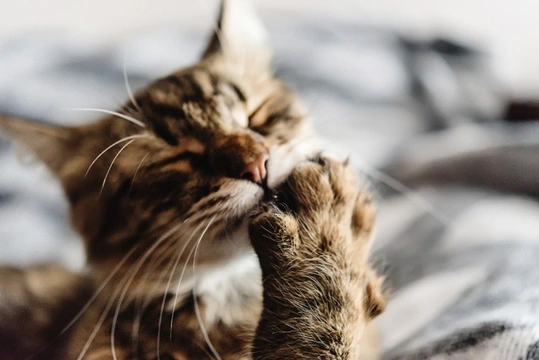
Cats and Overgrooming
Cats as a species are very finnicky about cleanliness, and as well as liking everything around them to be clean and just so, they also spend large amounts of their waking hours licking, grooming and caring for their coats.
Some experts say that cats spend up to half of the time they spend awake grooming their coats, which most of us would consider to be fairly excessive – but if your cat grooms themselves more than this, they may actually be overgrooming, which can both pose a problem in and of itself and potentially, indicate an underlying problem that is causing the issue.
However, precisely because cats spend so much time grooming as standard, it can be hard to tell if your cat is overgrooming themselves – and of course, why.
In this article, we will discuss how to tell if your cat is overgrooming, and some of the reasons that may be causing them to do so. Read on to learn more.
How much time do cats spend grooming themselves?
As mentioned, cats spend large portions of their time licking and grooming their coats, and so feeling as if your cat seems to be having a wash every time you glance at them may not necessarily constitute excessive grooming.
Cats tend to sleep for anything up to around twelve to sixteen hours a day in total, divided between periods of wakefulness – which means that of the remaining twelve to eight or so hours they spend awake, they might spend several hours a day grooming themselves, although this is at the top end of the scale and many cats won’t spend as long each day ensuring that they look perfect!
Identifying overgrooming
Because cats spend so much time grooming anyway, being able to recognise overgrooming is not as simple as it sounds. However, there are a few signs that in combination, may indicate that your cat is grooming themselves to excess, which means that you can keep an eye on things and assess what it going on.
If your cat seems to wake up all of a sudden and start grooming themselves and they do this a lot, they may be overgrooming – and waking up because their skin or coat is bothering them. Additionally, if they seem to always be grooming the same spot or area, this is a little unusual and may mean that something is wrong.
If you ever spot your cat physically pulling out tufts of their own hair, this is a type of overgrooming that very much bears further investigation, and even if you don’t see it happening directly, seeing lots of tufts of fur or areas of thinner hair in certain areas on your cat may give you a clue.
Also, if your cat washes their whole bodies so often that they often have slightly damp fur, this can indicate overgrooming. Anything else that seems out of place, different or unusual in terms of your cat’s fur or skin may also give you a clue too.
Additionally, if your cat seems to throw up a lot of hairballs, this can mean that they are grooming to excess, or that they are simply shedding heavily – which can happen as the seasons change, but if your cat sheds heavily all the time, they may have a skin or coat problem that in turn, leads to overgrooming.
The causes of excessive grooming in cats
You may need to talk to your vet to get to the bottom of why your cat is overgrooming, which may necessitate running some tests, and/or taking into account your cat’s temperament, lifestyle and other factors to determine if a behavioural issue is in play.
Here are some of the most common causes of excessive grooming in cats:
Parasitic infections
If your cat is infested with fleas, this will be very irritating to them and over time, can lead to an acute localised reaction to each bite, which is called fleabite sensitivity. Ear mites and other parasites that live on cats can also have a similarly irritating effect.
Reactions to topical medications
Using topical medications on cats – most commonly things like flea drops, powders and sprays – can lead to irritations that cause overgrooming, or simply bother your cat enough to make them want to lick and remove the substance from their coats.
If your cat has a systemic or localised reaction to a treatment, you will usually witness overgrooming in the days immediately following a treatment most acutely.
Dermatitis and skin conditions
Dermatitis and other conditions that make the skin sore, irritated or inflamed will all cause overgrooming and your cat paying a lot of attention to their coat and skin, so make sure you comb and examine their skin regularly to check for potential problems.
Allergies
Allergies – both topical allergies, food allergies and virtually any other type of allergy you can think of – will sometimes cause irritated skin, which again, will often lead to excessive grooming.
Alopecia
Alopecia is a medical condition that causes painless hair loss, which can soon lead to large bald areas of the coat as well as excessive shedding. A coat that has lots of loose shed hair will be rather uncomfortable for your cat, which can lead to them grooming more than normal.
Immune and hormonal disorders
Certain hormonal and immune-mediated health conditions can cause skin and coat problems, which may be itchy or irritating and lead to your cat continually bothering at their skin and coat.
Stress and anxiety
Finally, cats are very sensitive animals that don’t handle change or upset well, and if your cat is stressed or anxious about something, this can manifest as behavioural issues that may include excessive grooming.
Whatever the cause of your cat’s excessive grooming, talk to your vet to get to the bottom of the issue and work out a treatment protocol to keep your cat happy and comfortable.



